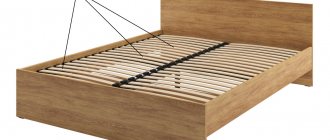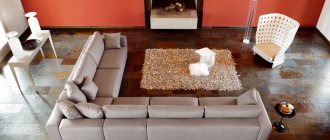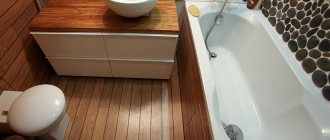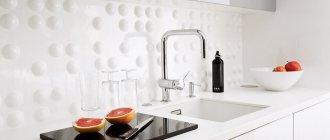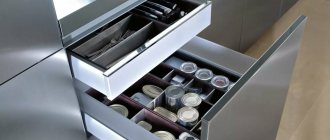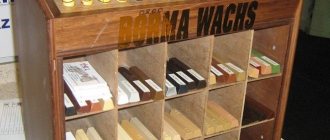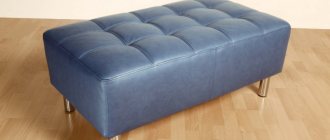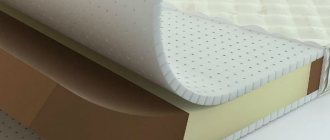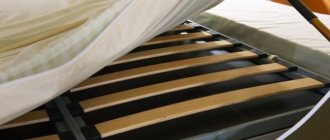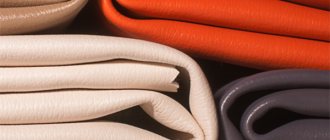What are the dimensions of the bevel?
The angle and size of the bevel on the edge of the mirror is chosen for a reason, but based on the thickness of the mirror sheet:
- From 0.5 to 2.5 centimeters inclusive for a mirror with a thickness of up to 4 millimeters.
- From 1 to 4 centimeters inclusive for fabric with a thickness of 5 to 6 millimeters.
The correct choice of bevel size depending on the thickness of the fabric is of great importance. If you make a too steep bevel on a thin canvas, in the future there is a high probability that the mirror will crumble or crack from the edge. To avoid this situation, the bevel size is carefully selected at the factory. The minimum size of the product for which such a bevel can be produced is 460x460 millimeters.
This is interesting: Examples of the location of mirrors of different shapes in the hallway, tips for choosing
Peculiarities
Translated from French, facet means “chamfer”. This is the outer edge, a special treatment of the outer mirror edge.
The classic technology involves processing the edge at an angle of 45 degrees, which ensures light refraction.
The beveled mirror shines beautifully, it looks expensive and presentable. Bevelling mirrors is different from engraving. It is performed on high-precision equipment in automatic mode. In this case, grinding, smoothing and polishing of the surface occurs along a given profile.
Such framing is safe - it is impossible to cut yourself on the beveled edge. Faceted mirrors differ in appearance and manufacturing method. Their key disadvantage is the need for regular maintenance. In this case, cleaning with a regular rag is not always effective. You have to resort to using special cleaning agents.
During processing, special grinding equipment is used. With its help, the sharp edge of the mirror sheet is processed very accurately and accurately. At the same time, small irregularities and chips (defects leading to cracks) are eliminated. Essentially, bevelling increases the strength of the mirror.
It is appropriate in a modern style, suitable for embodying a classic interior. This may involve the use of mirrors with or without frames.
Frames are selected for a specific interior style (for example, high-tech, Scandinavian).
How beveled mirrors are made
In the modern world, such decor is given to the canvas by highly qualified equipment with the possibility of diamond cutting with a special cutting tool equipped with program control. The procedure is so gentle and precious that it does not harm the characteristics of the glass, maintaining its impeccable appearance. High-tech equipment helps to achieve a level that will help satisfy the needs of the most sophisticated client.
The cost of this type of mirror
Beveled processing of the edge of the fabric is considered one of the most expensive due to its complexity. On average, the cost per square meter varies from 900 rubles. The cost is also affected by the thickness of the framed product; the thicker, the more expensive, from 3,500 rubles and above. If you want to give the canvas an unusual shade, not the same as we are used to seeing an ordinary mirror, the price of the product will increase. The total cost of such a product consists of the number of all processed edges.
Prices for bevel production
| ₽ | up to 10 mm | 20 mm | 30 mm | 40 mm |
| 140 rub. | 180 rub. | 240 rub. | 360 rub. |
You can see more detailed information on the cost of manufacturing bevels on glass and mirrors in the general price list for glass:
The presence in our production of the most modern equipment for processing bevels on mirrors allows us to fulfill the most complex orders in a short time, and our own fleet of special vehicles for transporting glass helps to deliver all manufactured products to the customer on time.
Varieties by processing method
Depending on the type of processing, there are several types of facets: straight, curved, double, triple. Each option has its own characteristics:
- Straight. Used on mirrors with a thickness ranging from 3–19 mm, with minimum parameters of 50 x 50 mm. Performed on products of simple geometric shapes - rectangular, square - without rounded corners. The width of the bevel reaches 4–30 mm, the cut is made at an angle from 3º to 7º.
- Curvilinear. The optimal thickness of the mirror should be 3–19 mm, the minimum dimensions are 110 x 180 mm. This method allows you to process round, oval blades, as well as products with curved shapes. The chamfer width reaches 5–50 mm, the edge is cut at an angle from 7º to 45º.
- Double and triple. When implementing this method, the cut is made twice or three times, each subsequent one being narrower than the previous one. The use of cutting is relevant for mirrors with different shapes and parameters.
The faceted mirror can be matted or polished. The former have a matte surface, the latter - transparent.
Straight
Curvilinear
Double
Why are facets needed?
At first it may seem that bevelling of mirrors has an exclusively decorative function. In fact, this is not entirely true. In addition to the decorative purpose, bevels on mirrors perform the following functions:
- Increasing the strength of the canvas. Bevelling eliminates mechanical defects, irregularities and chips, which not so rarely appear at certain stages of glass or mirror manufacturing.
- Increased operational safety. Bevel is the smoothing of sharp edges with further polishing of the edge. Due to this, the risk of injury and the possibility of cutting yourself on the edge of the canvas becomes almost impossible.
Bevelling is carried out using special grinding machines that process the surface of the mirror cloth with maximum accuracy and precision. Thanks to this, the procedure does not have any negative impact on the characteristics of the canvas, including its appearance.
This is interesting: How to choose the right height of a mirror in the bathroom, placement nuances
What is
The term bevel originated in France and is translated as outer edge, chamfer. It was there that the technology of decorative processing of the edges of mirrors and glass was first used. Framing gives the surface a finished look; it is made at an angle of up to 45º, due to which light is refracted and a special shine is emitted, giving the product nobility and sophistication.
Today, the decoration of mirror cloth is carried out using special equipment. This allows you to create different types of bevels. The most widespread is the one-sided version, which consists of side edges beveled on only one side. More interesting is the double-sided one; another edge is made along the wide edge - a narrower one. This technique gives the frame brightness and expressiveness, and a unique radiance appears due to the double refraction of light.
The secret to the popularity of the facet is its incredible visual effects. The beveled edges refract the rays of the sun, like a prism, dividing the light into multi-colored components. Many people, having learned what a bevel is, dream of decorating their own home or office with a similar element.
It is almost impossible to cut yourself when touching the original frame. During the production process, sharp edges are smoothed and thoroughly polished, so the risk of injury is reduced to zero.
Processing methods
There are several types of bevels, which allows you to choose the most optimal option for different products. Straight is performed on standard glass, shaped like a square or diamond, without rounded edges. Used for decorating coffee tables, partitions, doors, double-glazed windows.
The curvilinear method is suitable for processing non-standard shapes: ovals, waves, arches and other products with a figured contour. Double bevel is used to enhance the visual effect. The cut in this case consists of two stripes: narrow and wide, so the refraction of light will be stronger. The finished frame resembles a precious piece of jewelry and looks luxurious.
Triple involves chamfering multiple times. Each subsequent bevel is narrower than the previous one. This gives the canvas a decorative effect similar to a diamond cut. The more edges, the more beautiful the product.
To create the frame, frosted and polished processing is used, which gives the glass a special charm. A matte mirror with a facet made of transparent stripes looks unusual. On a canvas with a thickness of less than 5 mm, the edge is sanded simultaneously with the creation of decoration. If the values exceed 6 mm, the edges are processed separately.
The term "facet" is often confused with "falsetto". These are completely different concepts. The latter represents a high-pitched male or female voice.
Straight
Curvilinear
Triple
Matte mirror with bevel
Polished cloth
How to choose a quality product
Knowing exactly what it is - a bevel on a mirror, you can choose the appropriate decor for any home or apartment. But it is important to take into account some nuances so that the decoration is of high quality and lasts for a long time. For example, a distorted canvas can ruin the carefully thought-out decor of a room.
When choosing you need:
- Ask the seller for a manufacturer’s certificate indicating the materials used to create the product. The best option would be sheet silicate glass M1, M2, M3. The higher the thickness, the smoother the surface; optimal values are 4–6 mm.
- Carefully inspect the mirror and back sides for flaws: bubbles, irregularities, spots, scratches. The edges perform not only a decorative, but also a protective function.
- Carefully processed edges are the key to the durability and strength of the product.
Stylish mirrors decorated with bevels are successfully used to create interiors for the living room, kitchen, bedroom, hallway, and bathroom. Properly selected products visually enlarge the room, raise the ceilings, and bring sophistication and nobility to the room. Knowing how to choose this element correctly, you can create a unique decor.
Ask the seller for a manufacturer's certificate
Inspect the mirror and back sides for flaws
Overview of bevelling types
Bevelling of mirrors can be artistic or double, with a curved or straight bevel. Each type of cut has its own characteristics.
A simple facet is the most common and budget-friendly. Its edges represent a single slice. Double bevel looks more complicated. Its cut is two longitudinal bevels (wide and narrow). The shine of such edges is enhanced, the decorative effect is more refined. Triple bevel is distinguished by three cuts. Each of them is narrower than the previous one.
The curvilinearity and straightness of the facet are associated with the shape of the mirror sheet. Rectilinear can be found in mirrors with the shape of a square, rectangle, rhombus or other format without rounding or smooth lines. These mirrors have straight, beveled lines.
The curvilinear type of cut is typical for oval and round mirrors. In addition, it can be found in mirror paintings of an unusual shape (for example, made in the form of figures of animals, flowers, plants).
The volumetric bevel effect is a separate option for processing edges around the entire perimeter. It resembles a diamond cut and enhances not only the light but also the reflective effect. The facet can also be single-sided or double-sided.
In addition, bevelling can be polished or matte. The surface of polished panels is transparent.
According to the type of purpose, beveled mirrors can be functional or decorative. Products of the first group involve the use of mirrors for their intended purpose. Analogs of the second group are intended to decorate the space and change it visually. For example, with their help they create the effect of enlarging a room and increasing its illumination.
Depending on the purpose, mirror panels with a chamfer can be mounted in bathrooms, halls, offices, and kitchens.
For example, they make unique kitchen aprons. They are used to decorate niches and symmetrical inserts on bedroom walls. They equip office premises.
Mirror edge: beauty and safety
Glass for our mirrors is a ready-made material, which, of course, must be processed so that in everyday life it does not cause harm to the objects and people around it. Existing standards for flat sheet glass for creating special elements do not always accept one form or another for the interior. But we will now resolve this issue: mirrors are cut on special machines, the processing of their reverse side is changed, thereby obtaining a mirror made of reinforced, laminated, tempered and other types of glass.
Glass cutting is done with a diamond tool - a glass cutter. This household and fairly simple tool consists of a handle-holder and a diamond roller secured to it. To cut circular glass, you will need a compass tool, but it is best to buy a cutting table with a full automatic mode and carries out work with an accuracy of half a millimeter.
After cutting the mirror, you will need to grind its edges and then polish them.
Let's understand the process of grinding an edge with a coarse-grained material, which results in a rather rough surface with a matte finish. It’s ugly, of course, to hang such a mirror on the wall, especially since a processing angle of forty-five and even ninety degrees turns the product into a rough blank.
Roughness is removed by polishing, and this process is carried out on glass of both curved and rectilinear shapes. At the same time, the processing angle remains the same, but a fine-grained image is put to work. Step by step, the perimeter of the mirror is polished, and the work is done until the sides of the product become transparent.
With modern equipment, any polishing of a mirror is done using grinding wheels, but they have a diamond coating. The latest grinding machines not only work according to a given program, but are also ready to create contours such as a flower, a butterfly, a curved trapezoid, and so on. If you are familiar with the cascade mirror, then you now understand what we are talking about. Grinding of such products is carried out on a modernized washer machine. How? It’s simple: a mirror is placed on a disk rotating in a horizontal plane, and a stream of water is applied to its edge under pressure, to which either a formative powder or sand of a certain grain size and composition is mixed.
But mirrors are brought into proper condition on tape machines. Here the edges of the mirrors fall into the power of rotating rollers mounted on a special tape. To protect the glass from overheating, the edge is also cooled with water and abrasive powder. Such a machine produces only straight-line products, allowing you to significantly reduce its cost.
Processing the ends of both glass and mirrors allows the manufacturer to reduce residual stress on the product, sending products that are safe for living beings to the retail counter. In addition, the above procedure is always carried out before tempering any glass. Now not only is the edge quite strong, but the whole mirror is too.
Mirror polishing, like its grinding, is visible on display shelves, numerous counters, coffee and dining tables, aquariums, terrariums, bathroom shelves, and so on. Ordinary glass is polished more easily, using rotating grass brushes, which are pre-impregnated with pumice-water emulsion.
Sizes and shapes
The shapes of faceted mirrors are standard and non-standard. Faceted decor in the interior can be embodied in the most unexpected way. So, in addition to the traditional beveled mirror, it can be a mirror panel. The composition consists of rhombuses beveled at the same angle. Panels can be small and voluminous, flat and figured, with narrow and wide bevels.
Cut sizes vary depending on the type of facet. For example, the parameters of the straight version are 50x50 mm with a sheet thickness of 3-19 mm. The width of the cut can vary between 4-30 mm. The cutting angle can be minimal (from 3 to 7 degrees).
A round beveled mirror, which is of the curved type, has different edge dimensions. The width of the chamfer along the edges in this case can vary from 5-10 to 50 mm. In this case, the work uses a panel with a thickness of 3-19 mm with minimum parameters of length and width - 110x180 mm. Apply a chamfer at an angle of 7-45 degrees.
The bevel shape can be geometric. At the same time, the sizes of rhombuses, squares, hexagons are different (for example, 30x30, 500x500, 50x70 mm).
Also, the figures can be arbitrary. This allows you to create mosaic compositions of the most bizarre shapes.
Shapes of beveled mirror in the interior
A traditional wall mirror is not the only form of facet decor in the interior. There are other, more original ways to use it.
Panel
Beveled mirror panels are very common in home interiors. As a rule, such a composition is assembled from diamond-shaped elements, since edges beveled at an angle reflect light from windows or lamps more effectively than others.
Photo: dobrahata.com.u
The most common decoration option is to hang several panels on the walls of the room, especially if they are not too large.
Mirror wall
Another decoration option is to decorate the apartment not in individual areas, but in an entire mirrored wall with a beveled effect. It will serve as an accent, the brightest and most original wall in the interior. It will also replace the traditional mirror.
Photo: booxmaker.fr
It is important to place such a wall opposite a window or light-colored pieces of furniture to ensure the most effective reflection of light.
Faceted mirror on furniture
The most unusual and modern design option is to add furniture with a mirrored beveled surface to the room. It will become a very bright and original decor and will help add originality to the interior.
Photo: aviarydecor.com
The most common use of bevel on furniture is a cabinet with mirrored doors. However, there are more original design solutions: for example, a completely beveled coffee table.
Pros and cons of coverage
Faceted coating has a great advantage.
Thanks to which ordinary glass or mirror can be turned into a stylish element of the appearance of the room, giving the room sophistication in the interior. A beveled mirror will make the room brighter and visually expand the space. The advantage is that it is manufactured to the required dimensions, which will be selected by an experienced employee. Thanks to this technique, it will fit perfectly into the room. The disadvantages of such a product include constant and additional care; wiping with a regular wet cloth is not always effective and insufficient; the use of special means is necessary. But this is not the worst disadvantage compared to the beauty and advantage of a beveled mirror.
RECOMMENDATION ! Another role in the choice can be played by the high cost of production and manufacturing, but the recommendation is not to skimp on materials in order to get a high-quality canvas that will serve for many years.
Is it worth buying a beveled mirror?
Modern manufacturers and technologists do an excellent job with this technology. The canvas is obtained with perfect bevels and polishing. A product made in this style will last a long time, possessing its strength. And the graceful and aristocratic look will decorate the interior of the room for a long time. If you place the canvas in a metal or wooden frame, or baguette, it will fascinate with its mystery for many years. A beveled mirror cloth definitely has a great advantage in choosing decorative elements, especially such as a mirror, without which modern life is not possible. There is no doubt about buying this item, but feel free to think about the decision and go to the manufacturers.
Subscribe to our Social networks
Stages of making mirrors
Making mirrors requires increased caution from workers. In order to obtain an ideal mirror, production takes place using well-established technology and has the following stages:
- Cut and cut. Represents the marking and cutout of the required size.
- Treatment. The mirror is processed and the edge transformation is carried out.
- Installation of fasteners. Involves installation of mounting hardware.
- Washing. After the above steps, the product should be washed. This is necessary in order to clean the mirror from dust and dirt.
- Package. Includes design and proper packaging of the finished product.
Use in different rooms
The placement of a mirror often depends on the perspective of a particular room. For example, in a spacious hallway it can be placed on a free wall, not covered by furniture . This may be an option with a wide chamfer around the entire perimeter.
The living room can be decorated with symmetrical matted panels with a chamfer and lighting. They can be placed on both sides of the sofa. They will transform an ordinary interior into a festive one.
A spacious guest room can accommodate framed mirrors on either side of the fireplace. In this case, the bevel pattern can be elongated diamond-shaped.
A single small mirror will look good above a false fireplace.
When choosing a design in the kitchen, it is necessary to measure the volume of mirror surfaces.
It is better to decorate the interior with only a few inserts so as not to simplify the design. The facet in a small space should be modest and small.
In a room reserved for the dining room, unique decor can be placed on the wall near the dining group.
Moreover, it is not at all necessary to place the decoration on the entire wall. Its lower part can be decorated with floor cabinets, which is practical and functional.
If you don’t want to overload the bedroom space with an abundance of mirror inserts, you can decorate the walls with narrow framed canvases. The larger the area of the room, the larger the bevel can be.
In a recreation room equipped with built-in furniture, a mirrored finish may not be placed on all cabinet doors, but only on the central ones. At the same time, the bevel design may be different for door inserts and mezzanines.
In the bathroom, the easiest way to install a mirror is above the sink. It is convenient and practical, suitable for large and small spaces. The edge can be finished in a variety of ways, this is determined by the style of the interior and the taste preferences of the home owners.
Design options
Facet mirrors are designed in a variety of ways. In addition to the usual design and panels, it can be a mirror wall. This decoration makes the interior bright and unique.
This design is typical for rooms for different purposes (for example, in the bedroom, living room).
A beveled mirror wall can be located opposite a window or light-colored furniture. This will increase the light reflection effect.
This design is often complemented by lighting. In this case, the lamps are selected in the same style with the selected interior of a particular home.
A beveled mirror is often placed on furniture. For example, cabinet doors can be mirrored. A mirrored coffee table can be faceted. The mirror inserts of a set, chest of drawers, floor cabinets, and wall shelves are also beveled.
One simple solution is mirror tiles. This material can be used to lay out accent zones in different rooms of the home. This can be part of a wall or a specific area.
The facet can be patterned. It can be located not only along the edges of the mirror, but also in the center of the canvas. In this case, the sheet is glued with special glue. The canvas is also placed in baguette frames. Thanks to this, the effect of completeness of the interior composition is achieved.
Faceted mirror in the interior: dynamism and depth
A beveled mirror is a real designer decor. We tell you what faceted mirrors are, what makes them unique and how different they are.
What is a bevel on a mirror and how does such a mirror differ from a regular one? It's simple: it has beveled edges that refract light and shine brightly. This special cut turns an ordinary interior element into a beautiful decoration and, in some cases, makes it look like a real diamond.
A mirror with a facet will make the room brighter thanks to a larger number of reflective planes, and its design will be more stylish and original.
Faceted mirrors have several varieties - not only in appearance, but also in the manufacturing method. We will tell you in detail about all types of this decor and how to use it in the interior.
Photo: schlafzimmermobel.info
By appearance
Today, manufacturers offer us the following types: wall, mirror panels, mirror tiles, and a framed variety. Let's look at each type in more detail.
Wall mirror with bevel
Suitable for small rooms such as a bathroom or office. Thanks to this option, a small space will become visually wider.
Avoid hanging a beveled framed wall mirror opposite a window in darkened rooms. This arrangement will give a direct reflection of the sun.
It is better to hang the wall option at an angle to the window, which will add natural light to the room
Mirror panel
Ideal for large rooms (living room, for example).
A full-wall mirror panel can visually enlarge a room
The panel creates the illusion of expanding space. It also focuses attention on a specific subject.
If you want to highlight the painting, hang it opposite the panel.
Mirror tiles
Small beveled mirrors are used as tiles. Tiles can be laid in the bathroom, kitchen, or in any other room.
Mirror tile panels must be mounted at different levels, otherwise they will be reflected in each other.
Depending on the interior design, you can lay out part of the wall or arbitrary areas with beveled mirror tiles
